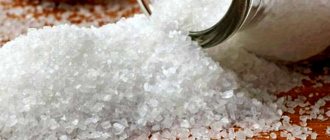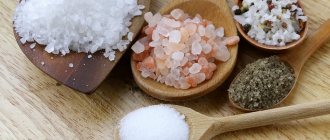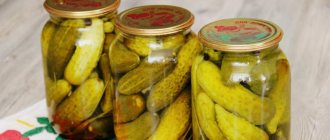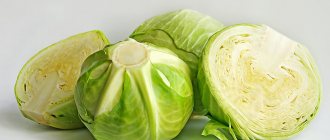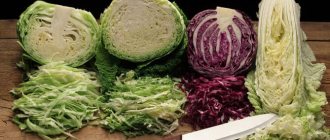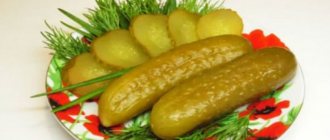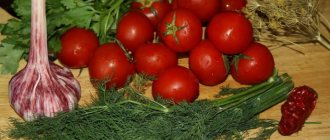How does salt affect the taste of canned food?
Since ancient times, ordinary crystals without any additives have been used for pickling vegetables. It is difficult for a modern person to understand the processes of product production. But you need to know that there are different types of grinding. Small crystals penetrate the fruits faster, speeding up the pickling process. And this does not always have a positive effect on the taste of cucumbers or tomatoes. It is better when vegetables are salted slowly. This is how they retain their beneficial qualities. Therefore, it is worth paying attention to coarse grinding.
The method of preparing the product determines the appearance of the preservation, its taste and aroma. Therefore, you need to know what salt to season cucumbers and other vegetables with.
Choosing salt for canning
Without your favorite seasoning it is difficult to imagine not only homemade preparations, but also daily dishes. But in order not to spoil your masterpieces, you need to learn how to choose a bulk substance.
The most important aspect is the size of the crystals. Fine-crystalline and powdery - this type of seasoning is perfect for preparing dishes and cooking marinades. Small particles dissolve instantly and quickly salt the product. Minus - they provoke accelerated fermentation.
Coarse and medium grinding - slow dissolution of crystals allows the lactic acid bacteria in vegetables to undergo the pickling process optimally. The products are piquant, firm and tasty.
Guided by simple rules, you can choose salt:
A nuance - when purchasing a spice for preservation, make sure that it does not contain any additives. The presence of such can spoil the products. The manufacturer may place moisture evaporation compounds and other components in the pack.
Types of salt
The quality of salt crystals depends on the extraction method. It is extracted from the ground using various techniques. Sodium chloride crystals are evaporated from sea water. Hence the different composition of the product, which affects the taste and quality of vegetable preparations for the winter.
Marine
Sea salt crystals differ in color and smell. And it depends on the place of origin of the product. Thus, gray salt contains particles of volcanic dust, clay from the seabed, and algae. The specific taste will be transferred to pickles.
See also
Recipes for quick-cooking pickled green tomatoes for the winter in jars and a saucepan
Read
Salt deposits mined in the Indian Ocean contain a lot of sulfur and other trace elements.
Large pure white crystals of sodium chloride are used for pickling cucumbers and sauerkraut.
Iodized
The fortification of foods with iodine began recently. This is due to a decrease in the consumption of foods with sufficient amounts of iodine. Without this substance, the functions of the thyroid gland malfunction.
There is no need to be afraid that iodized salt crystals will spoil the preparations for the winter. But this product is not suitable for all vegetables.
Stone
Mineral or stone is mined in mines. The crystals of the mineral are pure white. But sometimes sodium chloride is found with a grayish or yellowish tint. Color is related to composition. When using in canning, you should be careful, otherwise you can spoil the taste of the preparations.
Extra salt
This type is characterized by fine grinding. Minerals are mined from the depths of the earth's interior, so you first have to fill the deposit with water and pump out the solution. Then the liquid is evaporated or frozen out, which leads to fine crystallization. When using such a product, you should be careful. The concentration of sodium chloride is so high that it is easy to over-salt. Extra is rarely used in canning for the winter.
Self-sedimented, or cooked
A type of stone is one whose deposits are located at the bottom of reservoirs. It’s not for nothing that they call it self-sedimenting. As they precipitate, the crystals acquire a grayish color. This is due to the fact that soil particles got inside.
Crystals do not lose nutritional value; they can be used in wrapping vegetables.
What kind of salt is there?
Salt and salt are different. It can differ in the size and shape of the crystals, as well as in color, composition and even the degree of salinity. To list and describe all its varieties, you need not an article, but a mini-encyclopedia. But let’s ignore the “elite” options (Himalayan pink, black Thursday, Celtic, Fleur de Sel, kala namak, etc.). It is unlikely that you will have the idea to use them for homemade preparations, because... All this pleasure is not cheap. Instead, we will focus on the common types that are on sale in every store and which absolutely all housewives have heard about.
Salt
Table salt (otherwise called table salt) is the cheapest and most popular. It can be found in every kitchen. It is obtained by repeated recrystallization of brine or by purifying rock salt. During these processes, almost all impurities and trace elements are removed from it, and as a result, it consists of 97% or more pure sodium chloride. This explains its extremely pure (gourmets would say “flat” or “one-dimensional”) taste.
It is table salt without any additives that is ideal for canning and pickling. This is the most reliable and time-tested way to obtain excellent quality workpieces.
To prevent the salt from caking and forming lumps (especially for finely ground products), potassium ferrocyanide (E536) is added to it. This substance is banned in several countries. In addition, table salt with such an additive is no longer suitable for canning and pickling.
Rock salt
Rock salt is not a type, but a large class of salt. Often this name refers to coarse white table salt, which is most often sold in dense rectangular packages of 1 kg. It is usually white, but occasionally has a grayish or yellowish tint. Typically contains impurities. Moreover, if they are pronounced, this may become the basis for identifying a separate species (for example, black Himalayan salt).
What kind of salt is used
Before preparing pickle for cucumbers, you need to take the choice of ingredients seriously. Then you can safely store vegetables during the winter.
For preservation
It is better to cover cucumbers for the winter with coarse salt. This will help the canning brine soak in longer. In this case, the vegetables will retain all the vitamins and beneficial microelements. You will need salt of medium grinding, but pure, without impurities.
See also
TOP 22 delicious recipes for making pickles for the winter at home
Read
For pickling
Cucumbers are pickled using stone or table-type sodium sulfate. It is better if the composition is free of impurities and the color is pure white. For pickling you need a medium grind.
For marinating
The marinade for cucumbers is boiled in advance. Here it is better to use sodium chloride and coarse, medium, and fine grinding. With the latter type it is faster to marinate, it will dissolve instantly. It is important to maintain the proportions of salt in the marinade.
Myth three: sea salt tastes better
There's no denying that some of the smaller (read: more expensive) varieties of sea salt have interesting flavor profiles. But it depends on how they are used and what we mean by "taste".
The taste of food consists of three components: taste, smell and texture. In the case of salt, we can eliminate odor because neither the sodium chloride nor the magnesium or calcium sulfate that may be present in some less refined sea salts is odorless.
What do the taste buds feel and what is the tactile sensation of salt in the mouth? Depending on how the salt was collected and processed, the crystals of different brands of sea salt can vary greatly in shape, from flakes to pyramids to irregularly shaped fragments (you can see this if you take a magnifying glass). The size of the crystals also varies, from very small to large, although all are larger than regular table salt.
If this salt is sprinkled on relatively dry food, such as a slice of tomato, the larger, flakier crystals can create small patches of saltiness—when they touch the tongue and then dissolve, or when they land on the teeth and are crushed. That's why chefs value sea salt so much: for those little "flashes" of salty flavor. Table salt is incapable of this, since its compact small crystals dissolve on the tongue much more slowly. Thus, it is the complex shape of the crystals, and not their marine origin, that determines the taste characteristics of many types of sea salt.
The reason most sea salts have large, irregular crystals is because they are the result of a slow evaporation process, while the fast vacuum evaporation process used to make table salt leaves tiny, regular-shaped crystals, such as which easily spill out of a salt shaker with holes. This phenomenon is well known to chemists: the faster the crystal growth process, the smaller their size will be.
Is it possible to preserve cucumbers with iodized salt?
Deputies' proposals to sell only iodized salt leave housewives in shock: will it be possible to pickle cucumbers or not? The production of iodized products has changed, so there is no need to be afraid that cucumbers will spoil or taste bad. Nowadays, crystals are not enriched with sodium thiosulfate. Changes in the enrichment of crystals have led to the fact that it is possible to use an iodized product when pickling cucumbers. It will not affect the appearance, taste and preservation of preserved food for the winter.
Myth one: sea salt contains many beneficial minerals
If you evaporate all the water from the ocean (after removing the fish from there), you will be left with a sticky, gray and bitter mass of silt, 78% consisting of sodium chloride - ordinary salt.
The remaining 22% consists of 99% magnesium and calcium compounds, which are responsible for bitterness. In addition, at least 75 other chemical elements are present in very small quantities. This last fact is the basis for widespread statements about the “mass of nutrient minerals” in sea salt. However, chemical analysis will dampen our enthusiasm: minerals, even in such raw and untreated sludge, are present in insignificant quantities. For example, you would have to eat two tablespoons of this to get the amount of iron you get from a single grape.
The sea salt that ends up in stores contains only a tenth of the mineral content of raw sludge, and here's why: in the process of producing edible sea salt, the sun is allowed to evaporate the water from the ponds, but by no means all of it - and this is an important clarification. As water evaporates, the remainder becomes an increasingly concentrated solution of sodium chloride. When the concentration of salt in ponds is approximately nine times higher than that in seawater, the salt begins to transform into crystals. The crystals are then raked or scraped for subsequent washing, drying and packaging.
It is very important that this “natural” crystallization is itself an extremely effective purification process. Evaporation and subsequent crystallization from heating by the sun makes the sodium chloride 10 times purer—that is, free of other minerals—than it was in the ocean.
Why is this happening? Whatever aqueous solution you take, if it is dominated by one chemical substance (in our case, sodium chloride) along with many other mineral substances, albeit in much smaller volumes (in our case, other mineral substances of salt), when the salt evaporates the predominant substance will take the form of a crystal, and all other components will remain dissolved.
The salt, obtained through the solar evaporation of seawater, contains 99% pure sodium chloride, and no additional processing is required. The remaining 1% consists almost entirely of magnesium and calcium compounds, and all those other 75 “valuable minerals” are practically absent. To get the amount of iron contained in one grape, you will now have to eat about 100 g of this salt.
In this regard, the idea that sea salt already initially contains iodine is a myth. Because certain types of marine vegetation are rich in iodine, some people consider the ocean to be a kind of “iodized soup.” As for the chemical elements present in seawater, it contains 100 times more boron than iodine, but I have never heard sea salt advertised as a source of boron.

